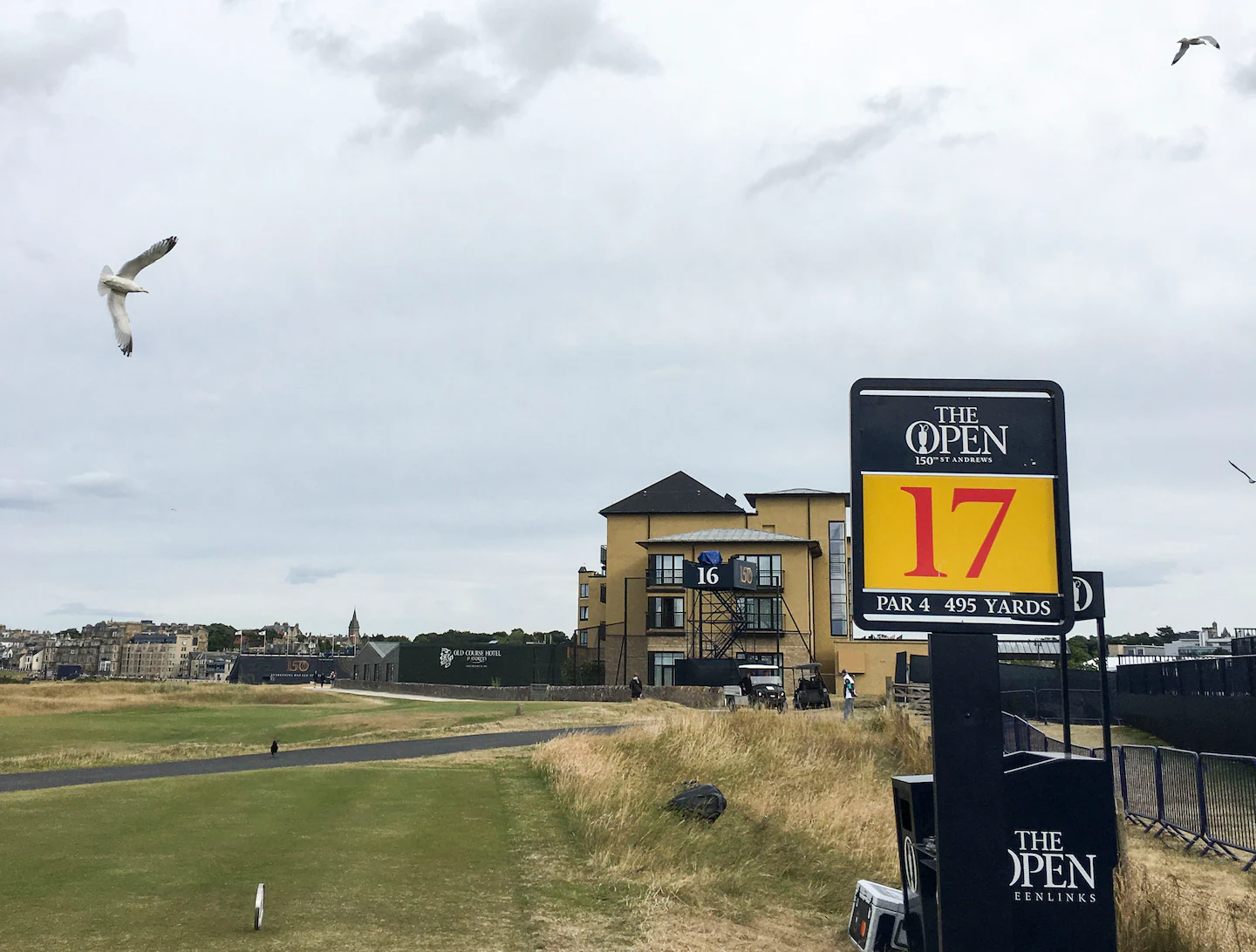It’s heavy and hallowed at “arguably our biggest event ever” in golf, the words of English golfer and frequent major contender Tommy Fleetwood on a British Open broadcast.
It hovers over at the Saint Andrews Cemetery, where the people from afar and more afar walk through and pay respects to “Old Tom” Morris (1821-1908) and “Young Tom” Morris (1851-1875), the father and son who won British Opens Nos. 2, 3, 5, 8, 9, 10, 11 and 12, four titles each. Now that the Open has reached No. 150, its celebrated sesquicentennial, it’s more evocative than ever to view the grave of “Young Tom,” a sculpture of whom stands ready to hit a ball that looks somewhat buried.
Maybe it’s harsh to have a guy face a bad lie into eternity, or maybe it’s complimentary to know he could handle it with aplomb.
In the pretty, stony gumdrop of a town founded around 1140, making it older than, say, Dallas, there’s history in the store windows, from which the late, magnificent Seve Ballesteros sometimes beams, his famed 12-foot putt from 1984 coaxing his famed fist pump plus the description as “the single happiest shot of my life.” The history breathes — and maybe even sips — a block up Golf Place from the course, at the Dunvegan Hotel restaurant and bar, also famed, where the ambitious sign in the window reads, “Good, fresh food served where you can eat with the Ghosts of Former Open Champions.”
The people are sardined in there these Open days, and the place appears to serve alcoholic beverages.
The Open has come back here, and the town of 16,800 with its university students from the world and its craggy golfers from nearby has gone into a mighty festival. The “150” logos shout from T-shirts, bark from caps and blare from the chairs painted to make “150” in the grandstands. Otherwise it might not look all that much different from previous Opens here, with 2015 the most recent, but it certainly feels like a whole lot of more.
The 10 p.m. daylight at latitude 56 North, always impressive, seems a bit happier this week. When the sunshine comes and the TV presenters describe it with the mandatory adjective “glorious,” everyone might nod. Now and then and here and there, there’s singing in the distance, maybe from a pub. “EVERYTHING LED TO THIS,” go the signs on the grandstand at No. 18, and everything is a lot, on a course founded in 1754 and storied ever since.
Visitor at “The Road Hole,” No. 17: “I’ve heard this is famous.”
Marshal, with lickety-split wit: “Some would say infamous.”
The past stays alive in the chatter, the history, as when Jon Rahm tells how humongous Ballesteros’s putt was in Spain or as when four men walk along No. 18 while one says, “Rocca had just done the putt in ’95,” meaning Costantino Rocca’s 60-footer from the depths of the green known as Valley of Sin to force a playoff with John Daly, who then won in a commendable show of strong-mindedness.
They walk along with the history here on the east coast near Saint Andrews Bay and the North Sea, along a course known for that wind among winds, the Scottish wind. “I can see how the course can play a million different ways, depending on the weather,” said defending Open champion Collin Morikawa, making his St. Andrews debut. That’s with the blind tee shots, such as at No. 3, where the vegetation up ahead stares at you like some horror movie in which the director already has conditioned you that something might jump out of there.
A marshal, David Roberts, explains where to aim.
Aim at the No. 15 tower up there.
He comes from nearby Lundin — not that other London — and because local clubs such as Crail and Leven manage certain holes, the Lundin Links club members will keep things sane this week at No. 3. He tells of the light show they had last spring, with about 6,000 in attendance, where a film of the history of the Open beamed off the walls of Royal & Ancient clubhouse.
“It wasn’t long after that,” he said, “that the stands went up. People that live locally have seen this getting bigger and bigger and bigger.” And: “And it has been building since the start of the year.” They even got the roads resurfaced, which should last a good while.
The 156 entries, up from eight in 1860, now try the odd, old course just a shout from town — as they do it in Scotland — with no trees or water, with 14 of its holes sharing seven greens, with the occasional purple flower and the frequent carnivorous bunker.
“I’d heard rumors,” said Scottie Scheffler, the Masters champion and No. 1 player in the world, “but to see it firsthand is definitely a lot different. What surprised me most is all the space off the tee where you’re trying to play into other fairways or just weird stuff like that.”
With fairways “like a motorway,” as Fleetwood put it on the Open broadcast — “I’ve never seen it this firm and fast” — suddenly a course noted for inviting width “becomes incredibly tight.”
“I can kind of see the history and how golf was designed to be played hundreds of years ago,” Scheffler said.
“Once you’ve got it figured out, you don’t,” said Will Zalatoris, the 25-year-old phenom who placed second at both the PGA Championship and the U.S. Open.
“It’s so bad down there,” Scheffler said of the iconic bunker on No. 17, having tried it out in practice.
There’s certainly history in the feeling that hits the eyes seeing the course, a feeling that might reach many of the 290,000 in attendance who, this week, come from among the 1.3 million who applied for tickets. Out at No. 13 not far from the little marsh with the mud and the gulls next to tee No. 12, the marshals come from Ladybank, about 20 minutes away.
“You think of what this land was,” marshal Steve Patrick says, “and things like the king [James II] prohibiting people playing golf here [in 1457] because they were playing golf and not practicing archery.” Patrick, too, recalls the light show as a kickoff of this “great buildup,” and he and Ladybank are excited even beyond Sunday. Gary Nicklaus will play Senior British Open qualifying Monday, and, Patrick said, “We’re hoping that Jack’s going to go there as well and see his son.”
There’s history in that, of course — Nicklaus won here twice, in 1970 and 1978 — just as there’s history everywhere except maybe the “glampground” near the course, what with “glamping” relatively new. Otherwise, it all goes back to Allan Robertson, whose death in 1859 led to the birth of the Open concept beginning in 1860. His tall tombstone, back near the Morrises, remains equipped with crossed clubs and a three golf balls in case he wants to come back out and play in a place where, this week more than ever, the ghosts are most welcome.



